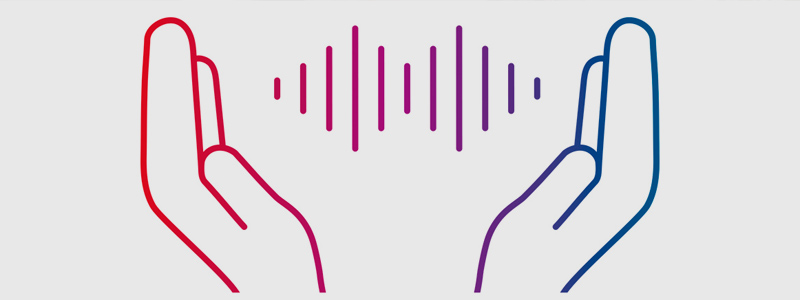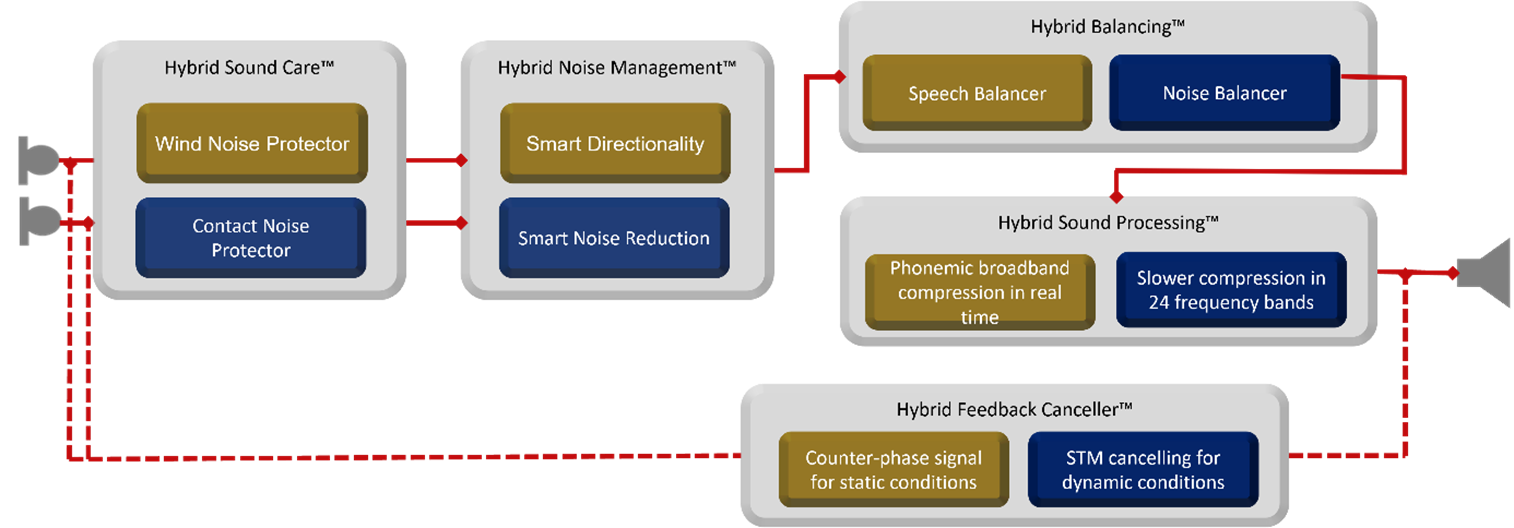Tackling wind and contact noise with Hybrid Sound Care™
21st June, 2023

As hearing healthcare providers, we want our clients to get as much benefit as possible from using their hearing aids. This means wearing them as much as possible, sometimes in environments where they may hear bothersome or even disruptive sounds. What happens, however, when these disruptive sounds lead the hearing aid user to want to remove their instruments, or even discourage them from enjoying certain activities? And what should be done to help?
Enjoying life outdoors
Being outside, enjoying the fresh air, participating in activities such as sports, socializing, or even just watching the world go by is important for many hearing aid users, and so naturally we want them to enjoy their auditory experience outside, too. Yet wearing hearing aids outdoors in windy conditions can pose a very real challenge for hearing aid users. Wind noise is caused by air passing over the microphones of the hearing aids and subsequently being amplified. Wind noise may be a result of the air moving, such as on a breezy day, or may be the result of a person walking, running, riding a bicycle, and so on. Despite improvements in perceived quality of life reported by hearing aid users in general, it was shown in the latest MarkeTrak analysis of hearing aid use that 23% of hearing aid users are dissatisfied with their ability to hear with their hearing aids outside (Picou, 2022).
Causes of wind noise discomfort
So, why is wind noise so disruptive and why does it get so loud for the hearing aid user? For a start, wind noise is rarely noticed by individuals without hearing aids since the pinna and the external ear canal reduce a lot of the noise created by wind at the tympanic membrane (Launer et al, 2016). For multi-microphone hearing aids, especially those worn behind the ear, the orientation of the microphones means that air rushing over them creates changes in pressure and velocity; in other words, turbulence. This creates acoustic signals that can be quite intense, measured up to 116 dB SPL with a relatively fast wind speed of 12m/s (Zakis, 2011), and are therefore potentially disruptive for the user. Wind noise is predominantly greater in the low frequencies, although there is some energy in the higher frequencies as well (Dillon et al, 1999).
The direction of the wind relative to the individual also influences the wind noise level. Greater wind noise levels are typically observed when the hearing aid user faces the direction of the wind, while lower levels are generally observed when the wind originates from the side of the person wearing the hearing aids (Korhonen, 2021). Turbulent air around the microphone inlets is particularly disruptive for directional microphone algorithms as the two microphones of a dual-microphone hearing aid are spatially separated. The air turbulence created by the air moving around the microphones is different at the two ports, so the resulting noise is defined as being uncorrelated (Chung, 2009). Noise reduction systems rely on reducing signals that are mostly stationary in relation to the hearing aid microphones. The noise in this case is very similar at both microphones and is therefore correlated. So, given the uncorrelated characteristic of wind noise, noise reduction systems are not efficient at removing the wind noise from the signal processing scheme (Korhonen, 2021).
Irritating contact noise
Contact noise can also be bothersome for hearing aid users. Everyday direct contact from putting on glasses, wearing face masks, or even adjusting hair creates contact noise when the object (hair, glasses, mask, etc.) scratches or rubs against the hearing aid or just the microphone ports. In many ways, this source of disruptive sound is similar to wind noise. This is because contact noise is also noise created by movement over the microphones that is uncorrelated and cannot be removed by the noise reduction system alone.
The trade-off with standard methods
So, what should be done to help the hearing aid user? In the past, the microphones on the hearing aid were covered in an attempt to reduce the wind noise. In many hearing aids, the only real option was to change the instrument directional pattern to omni directional (Kates, 2008). Another method was to reduce the gain in the hearing aid as a means of reducing the intensity of the wind noise. This may result in more comfort, but it can significantly reduce the amplification for signals of interest. This is especially true if the reduction occurs on a broadband basis or if the algorithm adjusts just a few bands across the entire frequency response of the instrument (Kates, 2008). The trouble with both approaches is that they are, to put it bluntly, disruptive, and affect the amplification of sounds that the hearing aid user might want to listen to. So, the next question is, how can the challenge be solved differently?
Tackling the problems at the source
With our new hearing aid family, Bernafon Alpha XT, we use a new system with the goal of reducing the intrusive nature of wind noise and contact noise. We call this system Hybrid Sound Care™. This feature is designed to reduce wind noise, as well as contact noise caused by hair, glasses, masks, etc. brushing against the microphone ports.
Figure 1 shows a block diagram of Hybrid Sound Care within the processing scheme of Alpha XT and how it is composed of the Wind Noise Protector and the Contact Noise Protector. This hybrid algorithm is applied after the microphones and the conversion to the digital domain within the hearing aid at the start of the signal processing path, to provide a cleaner signal for the subsequent processing. Now five complementary Hybrid Technology processing systems work together within Alpha XT.
Figure 1 Placement of Hybrid Sound Care™ within the signal processing path of Bernafon Alpha XT 9

How it works
Hybrid Sound Care uses a system of detectors that are able to detect the presence of wind and contact noise in 24 frequency bands and then reduce it selectively in each band, only where the wind or contact noise is present. This high-precision feature effectively protects the subsequent signal processing from wind and contact noise with 500 adjustments per second. The advantage of using this number of bands is that the system can reduce the noise in only the narrow frequency region where noise is detected. With this strategy, it is possible to reduce the effect of the noise and leave the rest of the signal intact.
Quality-of-life benefits
So, in effect, the Wind Noise Protector allows for a noticeable reduction in wind noise with the goal of enabling conversation in more windy situations with improved speech clarity. The same approach is applied by the Contact Noise Protector so that disruptive contact noise is reduced in a selected frequency band without completely reducing the gain, as other systems might have done in the past. Hybrid Sound Care is available in the new Bernafon Alpha XT hearing aids at the 5, 7 and 9 performance category levels, which we are excited to be launching this year. Hybrid Sound Care protects interesting signals like speech from disruptive wind and contact noise. Now you can let your clients experience the benefits that these systems provide, while also fulfilling one of our clinical goals of having our clients use their hearing aids all day wherever they may find themselves, even outside.
